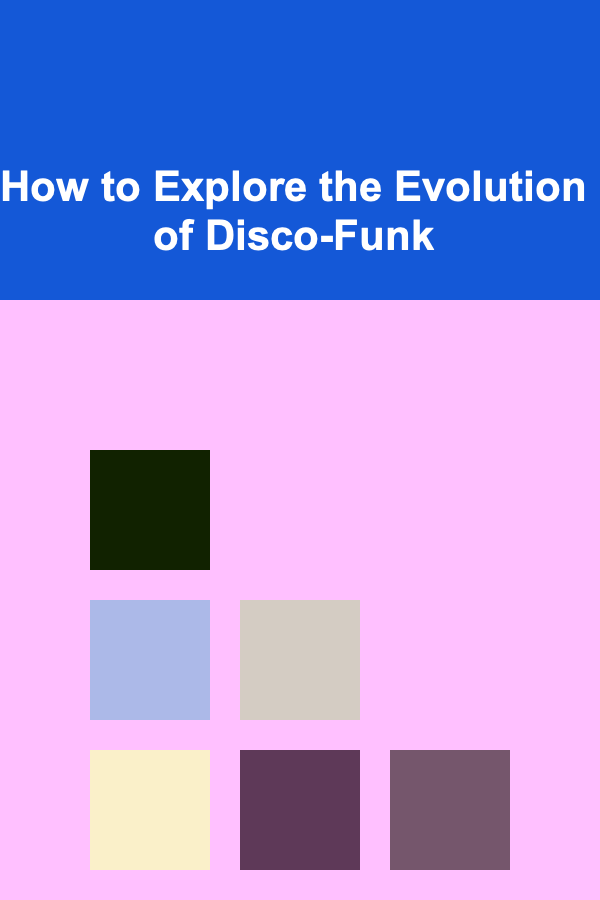
How to Explore the Evolution of Disco-Funk
ebook include PDF & Audio bundle (Micro Guide)
$12.99$6.99
Limited Time Offer! Order within the next:

Disco-funk is one of the most influential and dynamic genres in the history of popular music. Blending the pulsating rhythms of disco with the groovy basslines and rhythmic sophistication of funk, this genre carved out a cultural niche that still resonates today. To explore the evolution of disco-funk, we must journey through a series of musical, social, and technological transformations that spanned several decades, starting from the roots of funk music and extending through the peak of disco in the late 1970s and beyond.
In this article, we will dissect the origins, the rise, and the impact of disco-funk, exploring its connection with the civil rights movement, its relationship to pop culture, and its enduring legacy in contemporary music. Understanding how this genre evolved gives us insight into the interplay between music, social movements, and technology that reshaped modern popular music.
The Birth of Funk and Its Cultural Roots
To understand disco-funk, it is crucial to first examine the origins of funk music, which laid the groundwork for its fusion with disco in the 1970s. Funk emerged in the mid-1960s as an offshoot of rhythm and blues (R&B). Pioneered by artists like James Brown, funk distinguished itself through syncopated rhythms, prominent basslines, and a focus on groove. Brown's hits such as "Papa's Got a Brand New Bag" (1965) and "Cold Sweat" (1967) laid the foundation for funk's unique sound.
Funk was rooted in the African American experience, particularly the ongoing fight for civil rights. The genre's groove-based structure was not just a musical choice but a form of resistance. It was celebratory and rebellious, reflecting the vibrancy of black culture and the push for equality. Funk's rhythmic and energetic sound became a rallying cry for the Black Power movement and a reflection of the optimism and struggles of the time.
James Brown's "Sex Machine" (1970) is often considered one of the most iconic examples of funk's influence, offering intricate rhythms, tight arrangements, and a danceable groove that would later be absorbed into the fabric of disco. This track's influence is seen throughout disco-funk, especially in the focus on rhythm and bass.
The Rise of Disco
By the early 1970s, disco emerged as a prominent genre within the American dance scene. Disco originated in urban nightclubs, primarily in New York City, where marginalized communities, particularly LGBTQ+ individuals and people of color, came together to create a space for expression and liberation. Disco emphasized a steady 4/4 beat, high-energy dance rhythms, and orchestrated arrangements that blended soul, funk, and pop influences. Artists like Donna Summer, Gloria Gaynor, and the Bee Gees became some of the most popular faces of the disco movement, with hits like "Stayin' Alive" (1977) and "I Will Survive" (1978).
Disco was a celebration of excess, glamor, and freedom, and it quickly became synonymous with the nightclub culture. The disco ball, glittery outfits, and vibrant, strobe-lit environments were key symbols of this era, reflecting both the hedonistic and liberating aspects of the genre. However, disco also had a socio-political dimension. Like funk, disco was often an expression of marginalized communities' struggle for identity and acceptance.
At the same time, disco was highly commercialized, leading to its widespread appeal. Major record labels and producers, including the legendary Giorgio Moroder, began to create formulaic, polished hits designed for maximum appeal in both the club scene and on the radio. This commercialization and mainstream success gave disco a short-lived yet intense cultural prominence.
The Fusion of Funk and Disco
By the mid-1970s, disco and funk began to merge. Artists and producers started blending funk's intricate rhythms and grooves with disco's danceable beats and orchestral arrangements. The fusion of the two genres led to the birth of disco-funk, a subgenre that retained the infectious groove of funk but added the polished, four-on-the-floor rhythm structure of disco.
One of the key moments in the evolution of disco-funk was the release of "Super Freak" (1981) by Rick James. A mixture of funky basslines, rhythmic guitar, and flashy production techniques, "Super Freak" epitomized the spirit of disco-funk, blending party-ready vibes with intricate musical structures. James, who had already been influenced by funk icons like James Brown, pushed the boundaries of both genres in this track.
Another crucial artist in the disco-funk movement was Nile Rodgers, the guitarist and producer behind Chic. Chic's hit single, "Le Freak" (1978), combined the syncopated funk rhythms with the upbeat, danceable nature of disco. Rodgers's guitar playing, in particular, added a layer of sophistication and rhythmic complexity that became central to the sound of disco-funk. Chic's influence extended beyond disco into the early days of hip-hop and pop music.
The use of live instrumentation, particularly bass, guitar, and horns, was another defining feature of disco-funk. While early disco often relied heavily on synthesizers and electronic instrumentation, disco-funk incorporated elements of live funk bands, creating a sound that was more organic and groove-centric. This made it more aligned with the musical foundations of funk, while still maintaining the slick production values of disco.
The Social Impact of Disco-Funk
The popularity of disco-funk was not just a musical trend---it was also deeply tied to social movements and cultural shifts of the 1970s and early 1980s. As mentioned, disco's roots lay in the LGBTQ+ and minority communities, providing a space for freedom and expression at a time when social equality was still a major battle. The rise of disco-funk paralleled the growing visibility of these communities and the wider fight for civil rights and liberation.
The genre's exuberant, rhythmic music became a soundtrack to the celebration of identity. Disco-funk, with its funky grooves and celebratory nature, mirrored the ongoing fight for freedom and joy, even in the face of adversity. Its upbeat sound resonated with a generation that was coming to terms with both personal and societal struggles.
However, the rise of disco was not universally celebrated. In 1979, a backlash against disco emerged in the form of the so-called "Disco Sucks" movement. This reactionary wave was often tied to conservative, white, and heteronormative ideologies, which viewed disco as a symbol of the cultural changes brought about by marginalized groups. The famous "Disco Demolition Night" at a Chicago White Sox game in 1979 symbolized this backlash, and the moment marked a turning point in the genre's mainstream popularity.
Despite this, disco-funk remained influential in the subsequent decades, particularly in the world of dance music, hip-hop, and pop. Its rhythmic structures and emphasis on groove provided a fertile ground for new musical styles that emerged in the 1980s and beyond.
The Legacy of Disco-Funk in Contemporary Music
The legacy of disco-funk is evident in many aspects of today's music. The genre's focus on rhythm, groove, and live instrumentation has had a profound influence on genres like pop, R&B, dance music, and hip-hop. Contemporary artists such as Daft Punk, Bruno Mars, and Mark Ronson have all cited disco-funk as an influence in their music, incorporating its signature grooves and rhythms into modern tracks.
In particular, Daft Punk's 2013 album Random Access Memories featured the disco-funk influence prominently. The album's collaboration with Nile Rodgers on the hit single "Get Lucky" was a direct homage to the sound of disco-funk. The track's signature bassline and funky guitar riffs are reminiscent of the sound that Chic and other disco-funk artists pioneered in the late 1970s.
Bruno Mars's "Uptown Funk" (2014) is another example of how disco-funk continues to shape contemporary pop. The song, produced by Mark Ronson, is a celebration of groove, rhythm, and dance, drawing heavily on the disco-funk tradition. Its brass section and funky beats evoke the sound of 1970s dancefloors, and the song became an instant hit due to its irresistible rhythm and catchy hooks.
In the world of hip-hop, disco-funk's influence is also felt. Producers like Pharrell Williams have consistently incorporated funky basslines and syncopated rhythms into their tracks. The genre's emphasis on groove and rhythm makes it a natural fit for hip-hop's sample-based production style.
Conclusion
The evolution of disco-funk is a story of musical innovation, cultural change, and social movements. From its roots in funk and R&B to its fusion with the infectious rhythms of disco, the genre encapsulated the spirit of an era defined by both celebration and struggle. Its legacy continues to influence contemporary music, from pop to hip-hop, and its grooves are still felt on dancefloors around the world.
Understanding the evolution of disco-funk requires not only an appreciation of its musical complexity but also an acknowledgment of the social and political forces that shaped its rise. In this sense, disco-funk is more than just a genre---it is a cultural artifact that captures the joy, rebellion, and resilience of the 1970s and 1980s, making it as relevant today as it ever was.

How to Incorporate Color Into Your Home Without a Major Remodel
Read More
How to Leverage the Best Budget App on iPad for Travel Budgeting
Read More
How to Make Homemade Pet Treats Your Furry Friend Will Love
Read More
How to Organize Yarn by Color and Weight
Read More
How To Understand Roll-and-Write Board Games
Read More
How to Reduce Sugar Addiction for Lasting Weight Loss
Read MoreOther Products

How to Incorporate Color Into Your Home Without a Major Remodel
Read More
How to Leverage the Best Budget App on iPad for Travel Budgeting
Read More
How to Make Homemade Pet Treats Your Furry Friend Will Love
Read More
How to Organize Yarn by Color and Weight
Read More
How To Understand Roll-and-Write Board Games
Read More